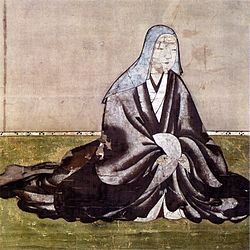This article includes a list of general references, but it lacks sufficient corresponding inline citations. (September 2023) |
於江与 Oeyo | |
|---|---|
 Portrait of Oeyo | |
| Born | Ogo (小督) 1573 |
| Died | October 26, 1626 (aged 52–53) Edo Castle, Musashi, Japan |
| Spouse | Saji Kazunari Toyotomi Hidekatsu Tokugawa Hidetada |
| Parents |
|
| Family | |
| Honours | Junior First Rank (従一位, 1626) |
Oeyo (於江与), Gō (江), Ogō (小督) or Satoko (達子) : 1573 – September 15, 1626) was a noblewoman in Japan's Azuchi–Momoyama period and early Edo period.[1][2] She was a daughter of Oichi and the sister of Yodo-dono and Ohatsu. When she rose to higher political status during the Tokugawa shogunate, she took the title of "Ōmidaidokoro".[3] Following the fall of the Council of Five Elders, Oeyo and her sisters were key figures in maintaining a diplomatic relationship between the two most powerful clans of their time, Toyotomi and Tokugawa. Due to her great contributions to politics at the beginning of the Edo period she was posthumously inducted into the Junior First Rank of the Imperial Court, the second highest honor that could be conferred by the Emperor of Japan.
Oeyo married three times, first to Saji Kazunari, her cousin, then to Toyotomi Hideyoshi's nephew, Toyotomi Hidekatsu. She had a daughter with Hidekatsu named Toyotomi Sadako later married Kujō Yukiie. Her third and last husband Tokugawa Hidetada became the second Tokugawa shōgun.[1] She was also the mother of his successor Iemitsu, the third shōgun.[3] She had Senhime, Tamahime, Katsuhime, Hatsuhime, Takechiyo (Iemitsu), and Tadanaga.[4] Hatsuhime was adopted by Oeyo's sister Ohatsu, who is married to Kyōgoku Takatsugu.
Surviving record books from merchants of luxury goods provide insight into patterns of patronage and taste amongst the privileged class of women like Oeyo and her sisters.[5]
- ^ a b Lillehoj, Elizabeth (2017-01-01), "5 The Artistic Legacy of Yōgen'in, A Mortuary Temple Sponsored by Women in Early Modern Kyoto", Gender, Continuity, and the Shaping of Modernity in the Arts of East Asia, 16th–20th Centuries, Brill, pp. 145–190, ISBN 978-90-04-34895-0, retrieved 2024-08-19
- ^ Rath, Eric C. (2004-12-08), "Bloodlines", The Ethos of Noh, Harvard University Asia Center, pp. 115–P8, ISBN 978-1-68417-396-9, retrieved 2024-08-19
- ^ a b Sekiguchi, Sumiko; Burtscher, Michael (2008). "Gender in the Meiji Renovation: Confucian 'Lessons for Women' and the Making of Modern Japan". Social Science Japan Journal. 11 (2): 201–221. ISSN 1369-1465.
- ^ Seigle, Cecilia Segawa (2017-01-01), "Tokugawa Tsunayoshi and the Formation of Edo Castle Rituals of Giving", Mediated by Gifts, Brill, pp. 116–165, ISBN 978-90-04-33611-7, retrieved 2024-08-19
- ^ Hickman, Money L. et al. (2002). Japan's Golden Age: Momoyama, p. 283.